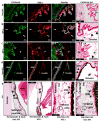A common variant mapping to CACNA1A is associated with susceptibility to exfoliation syndrome
- PMID: 25706626
- PMCID: PMC4605818
- DOI: 10.1038/ng.3226
A common variant mapping to CACNA1A is associated with susceptibility to exfoliation syndrome
Erratum in
-
Corrigendum: a common variant mapping to CACNA1A is associated with susceptibility to exfoliation syndrome.Nat Genet. 2015 Jun;47(6):689. doi: 10.1038/ng0615-689c. Nat Genet. 2015. PMID: 26018902 No abstract available.
Abstract
Exfoliation syndrome (XFS) is the most common recognizable cause of open-angle glaucoma worldwide. To better understand the etiology of XFS, we conducted a genome-wide association study (GWAS) of 1,484 cases and 1,188 controls from Japan and followed up the most significant findings in a further 6,901 cases and 20,727 controls from 17 countries across 6 continents. We discovered a genome-wide significant association between a new locus (CACNA1A rs4926244) and increased susceptibility to XFS (odds ratio (OR) = 1.16, P = 3.36 × 10(-11)). Although we also confirmed overwhelming association at the LOXL1 locus, the key SNP marker (LOXL1 rs4886776) demonstrated allelic reversal depending on the ancestry group (Japanese: OR(A allele) = 9.87, P = 2.13 × 10(-217); non-Japanese: OR(A allele) = 0.49, P = 2.35 × 10(-31)). Our findings represent the first genetic locus outside of LOXL1 surpassing genome-wide significance for XFS and provide insight into the biology and pathogenesis of the disease.
Conflict of interest statement
The authors declare no competing financial interests.
Figures



References
-
- Schlotzer-Schrehardt U, Naumann GO. Ocular and systemic pseudoexfoliation syndrome. Am J Ophthalmol. 2006;141:921–937. - PubMed
-
- Ritch R, Schlotzer-Schrehardt U. Exfoliation syndrome. Surv Ophthalmol. 2001;45:265–315. - PubMed
-
- Thorleifsson G, et al. Common sequence variants in the LOXL1 gene confer susceptibility to exfoliation glaucoma. Science. 2007;317:1397–400. - PubMed
-
- Fingert JH, et al. LOXL1 mutations are associated with exfoliation syndrome in patients from the midwestern United States. Am J Ophthalmol. 2007;144:974–975. - PubMed
Publication types
MeSH terms
Substances
Grants and funding
- R01 EY011721/EY/NEI NIH HHS/United States
- R29 EY011721/EY/NEI NIH HHS/United States
- EY018825/EY/NEI NIH HHS/United States
- HHMI/Howard Hughes Medical Institute/United States
- 085475/B/08/Z/WT_/Wellcome Trust/United Kingdom
- R01 EY018825/EY/NEI NIH HHS/United States
- EY023512/EY/NEI NIH HHS/United States
- R01 EY020928/EY/NEI NIH HHS/United States
- WT_/Wellcome Trust/United Kingdom
- 085475/08/Z/WT_/Wellcome Trust/United Kingdom
- P30 EY014104/EY/NEI NIH HHS/United States
- EY11721/EY/NEI NIH HHS/United States
- R01 EY023512/EY/NEI NIH HHS/United States
- R01 EY013882/EY/NEI NIH HHS/United States
LinkOut - more resources
Full Text Sources
Other Literature Sources

